Related Research Articles

Kandahar is a city in Afghanistan, located in the south of the country on the Arghandab River, at an elevation of 1,010 m (3,310 ft). It is Afghanistan's second largest city after Kabul, with a population of about 614,118. It is the capital of Kandahar Province and the centre of the larger cultural region called Loy Kandahar. Kandahar is the founding city and spiritual center of the Taliban. Despite the capital of Afghanistan being Kabul, where the government administration is based, Kandahar is the seat of power in Afghanistan as the supreme leader and his spiritual advisers are based there. Kandahar has therefore been called the de facto capital of Afghanistan, though the Taliban maintain Kabul is the capital.

The Battle of Maiwand, fought on 27 July 1880, was one of the principal battles of the Second Anglo-Afghan War. Under the leadership of Ayub Khan, the Afghan forces defeated a much smaller British force consisting of two brigades of British and Indian troops under Brigadier-General George Burrows, albeit at a high price: between 2,050 and 2,750 Afghan warriors were killed, and probably about 1,500 wounded. British and Indian forces suffered 969 soldiers killed and 177 wounded.
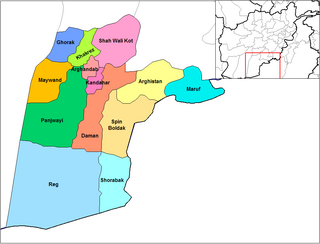
Panjwayi is a district in Kandahar Province, Afghanistan. It is located about 35 kilometres (22 mi) west of Kandahar. The district borders Helmand Province to the southwest, Maywand District to the west, Zhari District to the north, Arghandab, Kandahar and Daman districts to the east and Reg District to the south. Panjwayi was reduced in size in 2004 when Zhari District was created out of the northern part of it, on the northern side of the Arghandab River, which now forms the northern boundary.
Daman District is situated in the central part of the Kandahar Province, Afghanistan. It borders Panjwai and Kandahar districts to the west, Shah Wali Kot District to the north, Zabul Province to the northeast, Arghistan and Spin Boldak districts to the east and Reg District to the south. The population is 30,700 (2006). The center is the village of Daman, located in the central part of the district. The area is irrigated by the Helmand and Arghandab Valley Authority.

Maiwand is a village in Afghanistan within the Maywand District of Kandahar Province. It is located 50 miles northwest of Kandahar, on the main Kandahar–Lashkargah road.
Kandahar District or Dand District is situated in the central part of Kandahar Province, Afghanistan, surrounding the city of Kandahar. It borders Panjwai District to the west, Arghandab District to the north, Shah Wali Kot District to the northeast and Daman District to the east and south. The population is 468,200 (2006). The district center is the city of Kandahar.
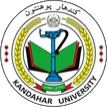
Kandahar University is a government funded higher learning institution in Kandahar, Afghanistan. It is one of two universities in southern Afghanistan. Kandahar University (KDRU) was established in 1990, at a time when the People's Democratic Party of Afghanistan (PDPA) was in power under President Mohammad Najibullah. Tooryalai Wesa, who returned to the country after 13 years and served as the governor of Kandahar province from 2008 to 2014, was the first chancellor of Kandahar University.
The Arghistan or Arghastan is a river in southern Afghanistan. It flows through Arghistan District and the provinces of Zabul and Kandahar. It is a tributary of the Dori River, a sub-tributary of the Helmand River. It flows for 280 kilometres (170 mi) and has a basin area of 20,219 square kilometres (7,807 sq mi).
The 2008 Kandahar bombing of February 17, 2008 in Kandahar, Afghanistan, was an attack targeting a crowd of people watching a dog-fighting competition. With more than 100 killed, it was the deadliest attack on Afghan soil since 2001.

The Battle of Arghandab began on June 18, 2008, when NATO-led forces attacked Taliban militants in response to Taliban attacks in Arghandab District and Kandahar. The battle in Arghandab marked the second time in less than a year that the Taliban has tried to take control of the area.

The Fall of Kandahar took place in 2001 during the War in Afghanistan. After the fall of Mazar-i-Sharif, Kabul and Herat, Kandahar was the last major city under Taliban control. Kandahar was where the Taliban movement had originated and where its power base was located, so it was assumed that capturing Kandahar would be difficult. The city fell after several weeks of fighting to a force of local militia under Pashtun military commanders and their American advisers. The fall of Kandahar signaled the end of organized Taliban control of Afghanistan.
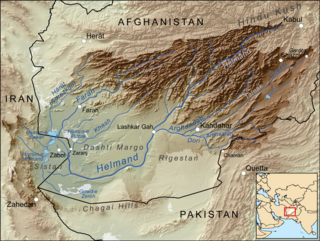
The Dori, also called the Lora and Kadanai, is a river of Afghanistan and Pakistan. It runs for 320 kilometres (200 mi) from Balochistan in Pakistan through Kandahar Province in Afghanistan, then flows into the Arghandab River.
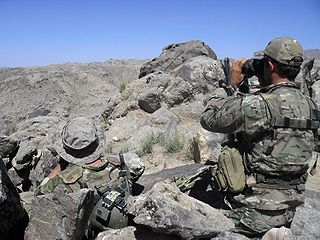
The Shah Wali Kot Offensive was a five-day joint operation during the War in Afghanistan, conducted by Australian special forces and the Afghan National Army with US air support, between 10–14 June 2010. The operation took place in the Shah Wali Kot District of Kandahar Province, occurring in preparation for the coalition clearance of the province and resulting in heavy insurgent casualties.

The siege of Kandahar began when Nader Shah's Afsharid army invaded southern Afghanistan to topple the last Hotaki stronghold of Loy Kandahar, which was held by Hussain Hotaki. It took place in the Old Kandahar area of the modern city of Kandahar in Afghanistan and lasted until March 24, 1738, when the Hotaki Afghans were defeated by the Persian army.
The 2001 Bombing of Kandahar was a series of military operations conducted in and around Kandahar, Afghanistan, during October 2001, as part of the start of the United States' military operations in Afghanistan.

Old Kandahar is a historical section of the city of Kandahar in southern Afghanistan. Many believe that there are hidden ancient treasures buried in and around the orange citadel.
Najeeban is a village in Panjwayi District, Kandahar Province, Afghanistan.
Balandi is a village in Panjwayi District, Kandahar Province, Afghanistan.
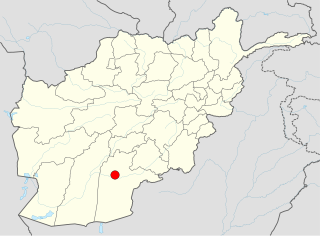
The Kandahar massacre, also called the Panjwai massacre, was a mass murder that occurred in the early hours of 11 March 2012, when United States Army Staff Sergeant Robert Bales murdered 16 Afghan civilians and wounded six others in the Panjwayi District of Kandahar Province, Afghanistan. Nine of his victims were children, and 11 of the dead were from the same family. Some of the corpses were partially burned. Bales was taken into custody later that morning when he told authorities, "I did it".

The Kandahar Greek Edicts of Ashoka are among the Major Rock Edicts of the Indian Emperor Ashoka, which were written in the Greek language and Prakrit language. They were found in the ancient area of Old Kandahar in Kandahar in 1963. It is thought that Old Kandahar was founded in the 4th century BCE by Alexander the Great, who gave it the Ancient Greek name Ἀλεξάνδρεια Ἀραχωσίας.
References
- ↑ "How it happened: Massacre in Kandahar". BBC News. 11 March 2012. Retrieved 11 March 2012.
Coordinates: 31°31′N65°30′E / 31.517°N 65.500°E
